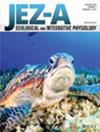脱氢表雄酮与雌性西伯利亚仓鼠攻击行为的双向作用。
IF 2.8
3区 生物学
Q2 Agricultural and Biological Sciences
Journal of experimental zoology. Part A, Ecological genetics and physiology
Pub Date : 2016-02-01
DOI:10.1002/jez.2001
引用次数: 17
摘要
性腺类固醇与攻击性之间有明确的正相关关系。然而,在一些季节性繁殖的物种中,在性腺退化和性腺类固醇循环水平相对较低的短暂“冬季”日子里,攻击性往往持续存在或增加。虽然短时间内攻击性增加的机制尚不完全清楚,但肾上腺雄激素脱氢表雄酮(DHEA)已被认为是调节季节性攻击的另一种神经内分泌机制。我们使用了两种互补的实验方法来研究雌性西伯利亚仓鼠的DHEA和攻击性的双向作用,雌性西伯利亚仓鼠是一种季节性啮齿动物,在短时间内循环DHEA升高会增加攻击性。在实验1中,我们在长昼和短昼仓鼠中检测了攻击相互作用对攻击相遇前后DHEA浓度的影响。血清脱氢表雄酮(DHEA)以光周期依赖的方式改变,在短而非长日的仓鼠中,脱氢表雄酮(DHEA)水平在攻击反应中下降。接下来,我们通过注射外源性ACTH实验诱导肾上腺脱氢表雄酮释放,并评估整个光周期内攻击行为的变化。在基线攻击试验中,我们发现与长时间相比,短时间的攻击行为明显增加;然而,在ACTH后的攻击试验中,两种光周期对ACTH的反应并没有进一步显著增加攻击性。这些发现表明,脱氢表雄酮在短日攻击的调节中起作用,同时也强调需要进一步的研究来解决脱氢表雄酮和其他物种攻击之间的因果关系。本文章由计算机程序翻译,如有差异,请以英文原文为准。
Bi-directional actions of dehydroepiandrosterone and aggression in female Siberian hamsters.
There is a well-established positive relationship between gonadal steroids and aggression. In some seasonally breeding species, however, aggression often persists or is increased during short "winter-like" days when the gonads are regressed and circulating levels of gonadal steroids are relatively low. Although the mechanisms underlying short-day increases in aggression are not fully known, the adrenal androgen dehydroepiandrosterone (DHEA) has been suggested as an alternative neuroendocrine mechanism regulating seasonal aggression. We used two complementary experimental approaches to examine the bi-directional actions of DHEA and aggression in female Siberian hamsters, a seasonal rodent that displays increased aggression concomitant with elevated circulating DHEA in short days. In Experiment 1, we examined the effects of aggressive interactions on DHEA concentrations before and after an aggressive encounter in long- and short-day hamsters. Serum DHEA was altered in a photoperiod-dependent manner, with decreased DHEA levels in response to aggression in short- but not long-day hamsters. Next, we experimentally induced adrenal DHEA release via injections of exogenous ACTH and assessed changes in aggressive behavior across photoperiods. We show a robust increase in aggression in short compared with long days during baseline aggression trials; however, aggression was not significantly increased further in response to ACTH in either photoperiod during post-ACTH aggression trials. These findings suggest that DHEA plays a role in the regulation of short-day aggression, while also highlighting the need for additional studies addressing the causal relationship between DHEA and aggression in this and others species.
求助全文
通过发布文献求助,成功后即可免费获取论文全文。
去求助
来源期刊
CiteScore
1.29
自引率
3.60%
发文量
0
审稿时长
6-12 weeks
期刊介绍:
The Journal Journal of Experimental Zoology Part A: Ecological Genetics and Physiology publishes articles at the three-way interface between Physiology, Ecology and Evolutionary Genetics. Contributions that help to elucidate how molecular, functional and ecological variation relate to one another are particularly welcome. The Journal publishes original research in the form of rapid communications or regular research articles, as well as perspectives and reviews on topics pertaining to the scope of the Journal. Acceptable articles are not limited to studies on animals, but also include research on plants and microbes.

 求助内容:
求助内容: 应助结果提醒方式:
应助结果提醒方式:


